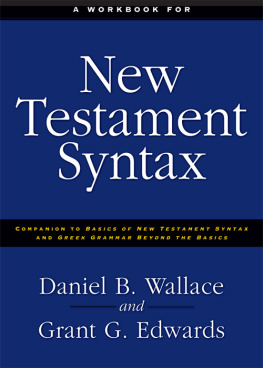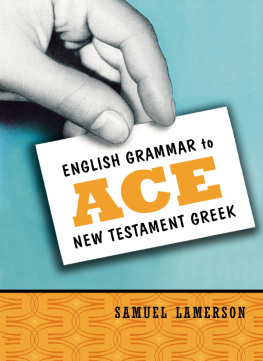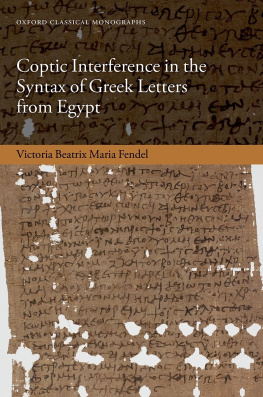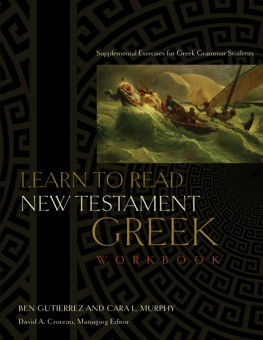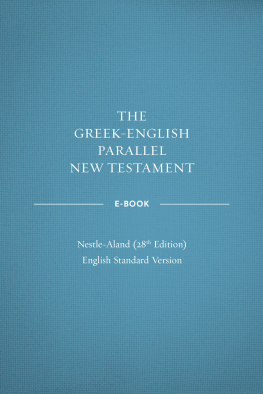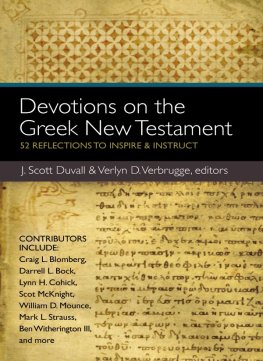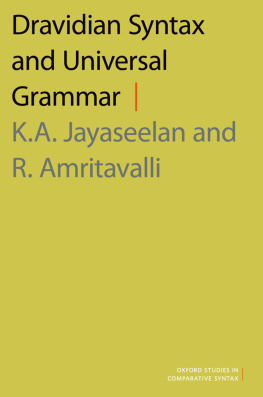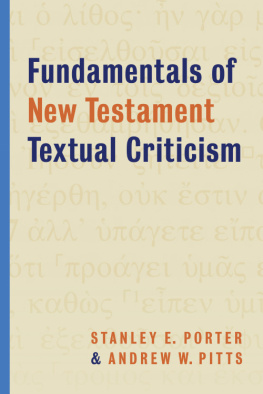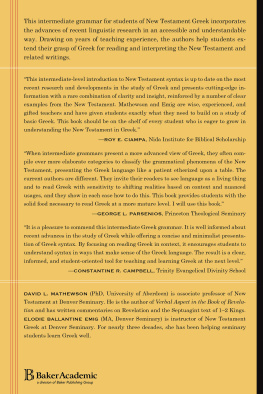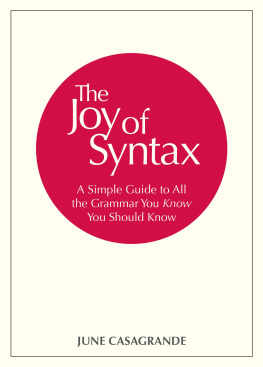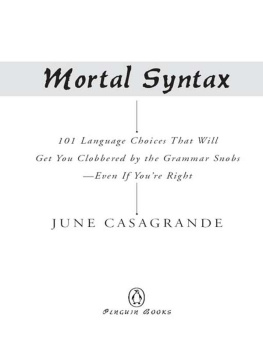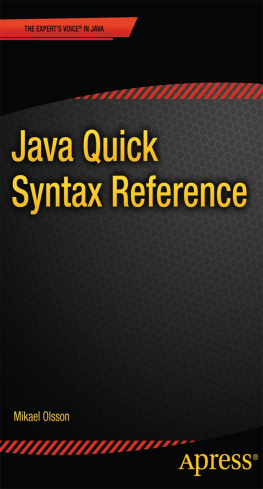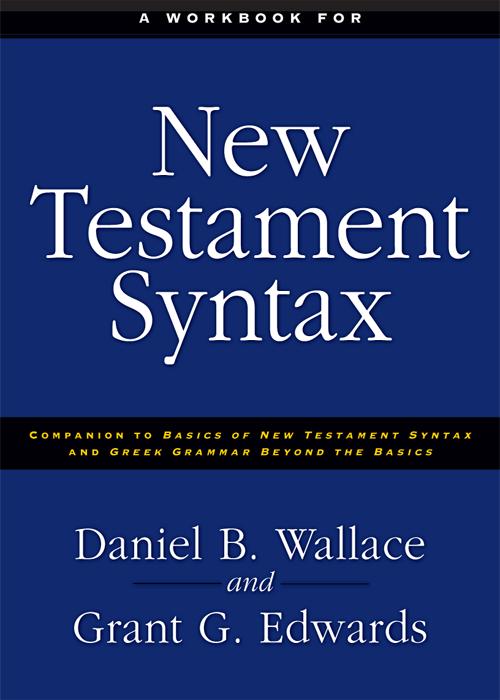A WORKBOOK FORNew
Testament
SyntaxCOMPANION TO BASICS OF NEW TESTAMENT SYNTAXAND GREEK GRAMMAR BEYOND THE BASICS:AN EXEGETICAL SYNTAX OF THE NEW TESTAMENTDaniel B. Wallace and
Grant G. Edwards
If the adage is true that practice makes perfect, then an essential component in mastering Greek syntax should be exercises in identifying the syntactical uses. There are, however, hurdles to overcome in designing a workbook for Greek syntax. The approach to the exercises is more of a challenge than one might think. Syntax, far more than translation or parsing, relies heavily on the context.
In order to offer drills in syntax, a sufficient context is necessary. This means that isolated verses, though valuable for a pedagogical book on syntax, have certain inherent deficiencies in a workbook. Consequently, the approach that asks students to translate individual verses and to identify various syntactical uses can never reinforce the more subtle nuances since it does not place those verses in their context. The alternative is to have students translate through a whole book of the New Testament, identifying syntactical features as they go along. This has the advantage of getting them to work within the context of the book. But it also has inherent disadvantages.
For one, the books of the New Testament were not intended to be utilized for syntactical analysis. Thus, many of the common categories of usage will simply not get reinforced. Second, the students get exposure to only one genre, leaving them with an artificial sense of the kinds and amounts of various syntactical features they will see in the New Testament. A Workbook for New Testament Syntax presents a tertium quid: it incorporates the strengths of both of the above approaches, while minimizing the weaknesses. Each lesson is comprised of 15 to 30 verses. These verses are continuous: that is, they are placed in their respective contexts and are prefaced by a brief introduction.
Usually two or three syntax clusters or passages that are rich in the particular syntactical categories under examination are in each lesson. As well, there are some warm-up verses that need little context to help the student determine the syntactical usage. All vocabulary words that occur less than fifty times are listed at the beginning of each passage. The advantages of this approach are that the students see syntax in context, get exposed to various genres and authors, and get practice in the common syntactical categories. Our goal, in fact, has been to include at least one question on each of the major syntactical categories. We believe that this approach will prove to be the least frustrating and most rewarding for the student.
This workbook has been especially designed to work with Daniel B. Wallaces Basics of New Testament Syntax (Grand Rapids: Zondervan, 2000; here abbreviated Basics) as well as with Wallaces Greek Grammar beyond the Basics: An Exegetical Syntax of the New Testament (Zondervan, 1996; here abbreviated ExSyn). But it should work well with virtually any intermediate grammar. There are three different ways to use this Workbook. (We are referencing these suggestions to usage with The Basics of New Testament Syntax.) First, in an ideal world the student should go through the following steps as he or she learns New Testament Greek grammar:
- Read through the section in the Basics, memorizing the gist of the arrowed and daggered categories. Also, become somewhat familiar with the rest of the categories.
- Read the Greek texts in this workbook out loud.
- Memorize the vocabulary listed below the Greek text (all words occurring less than fifty times in the New Testament) at least long enough to work through the translation.
- Translate the passages, at least mentally.
- Work through the Workbook, checking your answers with the descriptions of the usages in Basics.
Thats in an ideal world.
Of course, we are well aware that students tend to find (what they think is) the path of least resistance (we know; weve done it ourselves!). They also succumb to the tyranny of the urgent. What often happens is the practical route:
- Read through the section in the Basics, memorizing nothing.
- Skip the reading of the Greek text out loud.
- Only glance at the vocabulary list as necessary.
- Do a rough translation in your mind, but one that is not particularly coherent.
- Give answers to the workbook questions thirty minutes before the class starts so that something can be written down. Fake your way through oral recitation.
But there is a
via media approach. The professor should encourage students to take the ideal route as much as possible, since it really will save time and increase retention. Nonetheless, this final approach involves some helpful shortcuts:
- Read through the section in the Basics, writing down the keys to identification for the arrowed and daggered categories.
- Read the Greek texts in the Workbook out loud.
- Open your copy of the Greek New Testament and photocopy the vocabulary lists so that you can consult both as you work through the syntactical questions.
- Translate the texts, at least mentally.
- Work through the Workbook, consulting Basics as you go.
If the professor requires the ideal method, there are ways in which he or she can test the students to see if they are following it.
But in the least, we recommend that the via media approach be followed. The basic issue will be that the terminology for the syntactical categories differs from grammar to grammar. But this should only cause problems if the teacher intends to use the answer key that we are providing for this workbook. With a few adjustments, even that should cause little difficulty. Arrowed categories refer to those usages that are common in the New Testament and should be committed to memory.
As you complete the exercises in this
Workbook, there are a few things to keep in mind:
- The twenty lessons correspond approximately to the chapters in Daniel B. As you complete the exercises in this Workbook, there are a few things to keep in mind:
- The twenty lessons correspond approximately to the chapters in Daniel B.
Wallaces Basics of New Testament Syntax (Basics) and Greek Grammar beyond the Basics: An Exegetical Syntax of the New Testament (ExSyn). But there are no specific lessons on prepositions, conjunctions, or pronouns. Questions about these items are integrated into the other lessons. In the first few lessons, page numbers in both Basics and ExSyn are listed with these questions to remind you to look in those chapters for the answers.
- All numbered items are questions that need to be answered. Bullet points give you information that is useful to translation, syntactical analysis, and other aspects of the Greek text.
- All lessons are worth at least 100 points. A few lessons are actually worth more than 100 points, with a few bonus points built in. This is because of the difficulty of the material and the potential ambiguity of the answers.

